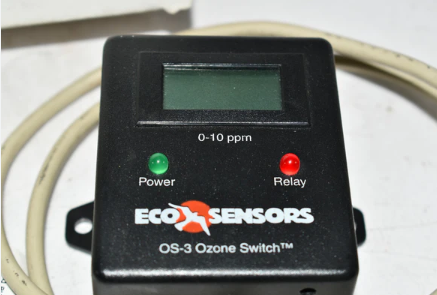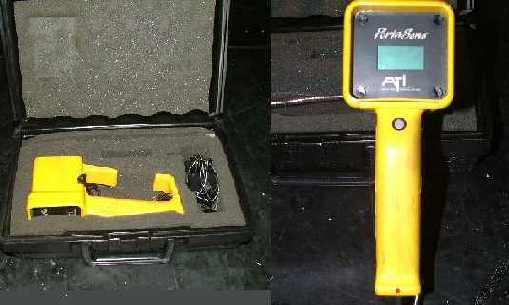The Model OS-3 is a versatile device designed to act as a thermostat for controlling ozone generators and alarms based on an adjustable ozone set-point. The standard available range is 0-10 ppm. This device incorporates hysteresis or a “dead band” to prevent system “chatter,” which can occur when the ozone concentration is near the set-point. The SPDT relay contacts can handle loads of up to 5 amps at 250 volts or up to a 1/8 HP motor.
It is important to note that the OS-3 should not be used in the presence of acid gases, strong volatile organic compounds (VOCs), or strong halogen fumes. The instrument is conditionally warranted for one year. Therefore, it’s essential to save a copy of your purchase document as proof of purchase and read the warranty statement at the end of this manual.
Operation
- Initial Setup: Verify that the instrument is working correctly as received. Connect your AC adapter to the power jack or your 12-24 V DC power supply to terminals 4 and 5 of terminal block TB1, located on the inside back of the instrument. Ensure that the input voltage does not exceed 24 volts and is not AC. Using the wrong voltage can lead to significant damage to the instrument.
- Sensor Conditioning: The ozone sensor must be conditioned to burn off any chemicals it may have absorbed during shipping and storage before it can develop full ozone sensitivity. Allow 1-8 hours of warm-up time before testing the instrument and at least 24 hours before using it.
- Test Instrument Response: It is recommended to test the instrument for a positive response with an ozone generator upon receiving it and again at the installation site. Eco Sensors, Inc. offers a battery-operated, hand-held ozone generator, the Model OG-1, designed for this purpose.
- Adjust the Set-Point: You can adjust the set-point as needed, but it should not be set below 0.5 ppm.
- Data Logging: If required, a data logger can be connected to TB1 terminals 1 and 2, providing an output range of 0-2 volts, where 1 volt is equivalent to 10 ppm of ozone concentration.
- Connect to External Devices: The Ozone Switch™ can now be connected to external devices, such as an ozonator to be controlled or an alarm circuit. Ensure that you disconnect the power to the generator control wiring and the DC power to the instrument while making these connections. Route the external wiring through the bottom access hole of the instrument or drill access holes as needed.
Calibration
The Ozone Switch™ is shipped from the factory calibrated to detect ozone at 10 ppm. Lower detection values are adjustable using the calibration control located inside the back cover. The calibration should be within 20% accuracy in the range of 0.5 to 10 ppm. Operating the instrument with a set-point below 0.5 ppm is not recommended. Calibration can be affected by environmental factors, such as the presence of greases, oils, solvents, VOCs, extremes of temperature and humidity, or oxidizing chemicals like acid gases. It’s important to recalibrate the instrument after changing the sensor and at least annually.
Service and Maintenance
For the longevity of your OZONE SWITCH™ Model OS-3, keep the following points in mind:
- Sensor Replacement: In the event of sensor failure or deviation from correct calibration, replace the sensor module (part no. SM-10) rather than attempting to repair or recalibrate it. Board-level repairs can void the warranty.
- AC Power Adapters: Ensure that the instrument receives 12-24 V DC at 200 mA for proper operation. AC adapters can be replaced, and Eco Sensors can supply an AC adapter for North America.
Specifications and Safety Features
The Model OS-3 boasts the following specifications and safety features:
- Sensor: Heated metal oxide semiconductor operating at 200 degrees C.
- Standard Operating Range: 0-10 ppm.
- Accuracy: 20% in the 0.5-10 ppm range.
- Response Time: Within 2 minutes of ozone reaching the sensor.
- Temperature and Humidity Range: 50-80°F (10-27°C), 30-60% relative humidity.
- Supply Voltage: 12-24 V DC, 200 mA.
- Relay Contacts: SPDT non-latching, 5 amps, 250 volts AC, or 1/8 HP inductive load.
- Enclosure: Flame retardant ABS, UL approved.
Precautions
To ensure the safety and proper functioning of the OS-3, follow these precautions:
- Allow for proper warm-up time before testing or operational use.
- Keep the instrument dry, away from water and liquids.
- Avoid excessive vibration and high levels of dust.
- Do not attempt board-level repairs.
- Avoid exposure to certain chemicals, such as chlorine or other halogen compounds, sulfur compounds, strong VOCs, urine residues, ammonia compounds, and acid gases.
When in doubt, operate the instrument in your worst-case environmental condition for 24 hours to verify its proper functionality.
The manual for this unit can be found here: https://www.gas-sensing.com/downloads/EcoSensors/os3.pdf



